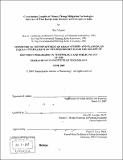| dc.contributor.advisor | Alice H. Amsden. | en_US |
| dc.contributor.author | Mizuno, Emi, Ph. D. Massachusetts Institute of Technology | en_US |
| dc.contributor.other | Massachusetts Institute of Technology. Dept. of Urban Studies and Planning. | en_US |
| dc.date.accessioned | 2008-01-10T16:06:21Z | |
| dc.date.available | 2008-01-10T16:06:21Z | |
| dc.date.copyright | 2007 | en_US |
| dc.date.issued | 2007 | en_US |
| dc.identifier.uri | http://hdl.handle.net/1721.1/39947 | |
| dc.description | Thesis (Ph. D.)--Massachusetts Institute of Technology, Dept. of Urban Studies and Planning, 2007. | en_US |
| dc.description | Includes bibliographical references (p. 380-407). | en_US |
| dc.description.abstract | This research investigated the causal factors and processes of international development and diffusion of wind energy technology by examining private sector cross-border technology transfer from Denmark and Germany to India between 1990 and 2005. The motivation stemmed from the lack of active private sector participation in transfer of climate change mitigation technologies. Special attentions were paid to the role and effects of: government policy and institutional settings; co-evolution of policy, market, industry, and technology; and industrial competitiveness management. The research found that the centrality of government policy, in particular market value creation/rewarding policy, in successful wind energy technology development and diffusion at the technology frontier of Denmark and Germany. Sources of technological change were complex, but it was the policy-induced substantial market size and performance-oriented demand characteristics that determined the speed and direction of technology development and diffusion. Yet, the change was only materialized by the successful establishment of co-evolving mechanism of policy, market, industry, and technology; again, policy was central in the creation and timely adjustment of such virtuous cycle. | en_US |
| dc.description.abstract | (cont.) The research also found strong connections between technological characteristics/specificity and industrial competitiveness management, and their intertwined transformations. On the Indian side, the increasing technology gaps in both product and capability with the frontier and the transformed structural relationship between market development and the number of new technology introduction were evident from the mid 1990s. Non-performance-oriented market mechanism, policy inconsistency, institutional problems of power sector, persistent infrastructure deficiency, along with the intertwined competitiveness management and technology transformations at the frontier, all contributed to the structural transformation; the failed virtuous cycle creation was due to strong technology- and industry-related external factors and weak demand-pull and supply push internal policy. India lost the potentials for replicable technology transfer and the larger development benefits. | en_US |
| dc.description.statementofresponsibility | by Emi Mizuno. | en_US |
| dc.format.extent | 434 p. | en_US |
| dc.language.iso | eng | en_US |
| dc.publisher | Massachusetts Institute of Technology | en_US |
| dc.rights | M.I.T. theses are protected by copyright. They may be viewed from this source for any purpose, but reproduction or distribution in any format is prohibited without written permission. See provided URL for inquiries about permission. | en_US |
| dc.rights.uri | http://dspace.mit.edu/handle/1721.1/7582 | |
| dc.subject | Urban Studies and Planning. | en_US |
| dc.title | Cross-border transfer of climate change mitigation technologies : the case of wind energy from Denmark and Germany to India | en_US |
| dc.type | Thesis | en_US |
| dc.description.degree | Ph.D. | en_US |
| dc.contributor.department | Massachusetts Institute of Technology. Department of Urban Studies and Planning | |
| dc.identifier.oclc | 183207171 | en_US |
